
The Serious Freshening
Go to <Last, Summary, Next>Interior—Instrument Panel Facia
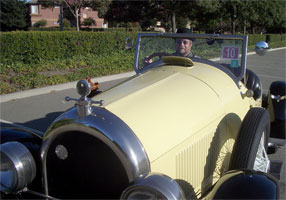 Lynn in Bugsby, September 5, 2005 |
Completed: 2007-10-19 — Started: 2006-07-01
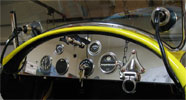 NEW FACIA: Polished metal instrument panel cover like that originally delivered with Bugsby. |
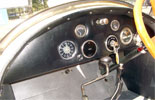 OLD FACIA: This is the padded black-vinyl panel cover that arrived with Bugsby in 2005. |
Work Completed:
Lynn believes that the padded black-vinyl facia on the instrument panel that was on Bugsby when he received it
in 2005 is not the original factory treatment.
From his inspection of the
Kissel Instruction Book No. 7
and other Kissel Speedsters, Lynn thinks that the
facia should be polished metal or painted metal matching the body color.
Working through Kevin Schell at California Reflections, a new polished stainless-steel facia has been acquired.
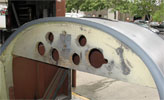 |
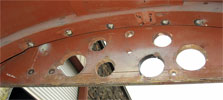 |
| CRACKED WOOD: Instrument panel backing board is severely cracked. |
Closer inspection of the board that forms the instrument panel reveals long horizontal cracks. This particularly concerns Lynn since the steering column is attached here and depends upon the strength of this element to help keep the column from pivoting when the wheel is turned. A failure of the column pivot point would result in lose of steering control.
For several days Lynn tries to remove the old instrument panel board but finally concludes that it is integral to the construction of the cowl. The wood frame pieces are constructed in such a way that the board cannot be removed without removing the sheet metal and dismantling much of the cowl. Yikes!
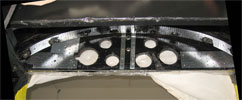 |
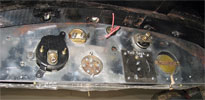 |
| REINFORCING THE DASH: Abandoning his first reinforcing effort (left), Lynn uses the old instrument panel facia as rear reinforcement (right). |
Instead, Lynn decides he will reinforce the existing board. Using metal "tie plates" used in wood house framing, Lynn attempts to reinforce the dash board. He abandons this approach as it appears too ugly and he hasn't achieved the coverage and strength he wants.
For his second attempt, he reverses the old metal that covered the outside of instrument panel and uses it on the inside. Now the cracked wood is sandwiched between two layers of metal. Lynn feels that this will provide sufficient strength and is more attractive than his first strengthening effort.
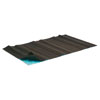 |
 |
| BODY INSULATION: Sound deadening self-adhesive black body insulation have been installed. |
While working on the instrument panel, Lynn notices that large flat sections of body metal are accessible from the inside, between the members of the wooden frame. As he learned from Kevin Schell, there exist asphalt-based self-adhesive sheets that can be stuck to these exposed portions for body metal, reducing resonant vibrations and giving the car a quieter and more solid feel.
Lynn buys a stack of twelve 10"x13" sheets from JC Whitney, applying them throughout the cowl, doors and rear storage compartment. Since he has already painted these panels black, the body insulation is almost invisible, yet it has a dramatic effect. The doors shut with a satisfying "thunk" and the body doesn't sound hollow and tinny when thumped with a knuckle.
Lynn feels that it would be reasonably easy to remove the body insulation if that was desirable. This is his goal for any modern enhancements that he makes to Bugsby.
Work Remaining:
None.
Contact
 with your comments or questions
with your comments or questionsCopyright © 2018 Lynn Kissel
Last updated: May 24, 2009